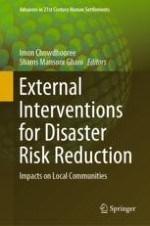2020 | OriginalPaper | Chapter
A Complexity Approach for Reducing Disaster Risks for Marginalized Urban Populations: Comparing DRR Interventions Across Four Cities
Author : Aaron Clark-Ginsberg
Published in: External Interventions for Disaster Risk Reduction
Publisher: Springer Singapore
Activate our intelligent search to find suitable subject content or patents.
Select sections of text to find matching patents with Artificial Intelligence. powered by
Select sections of text to find additional relevant content using AI-assisted search. powered by
